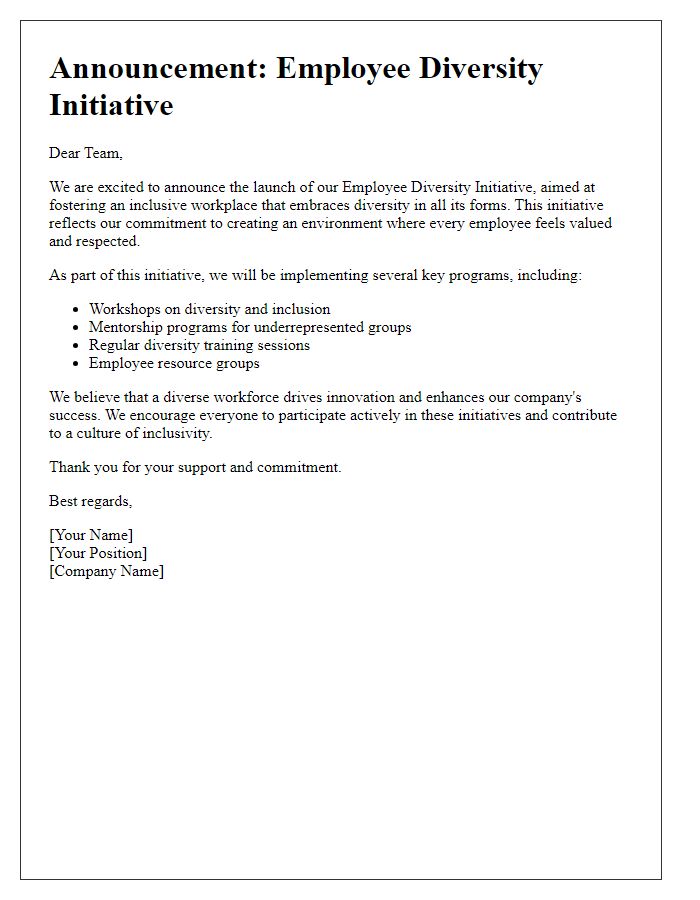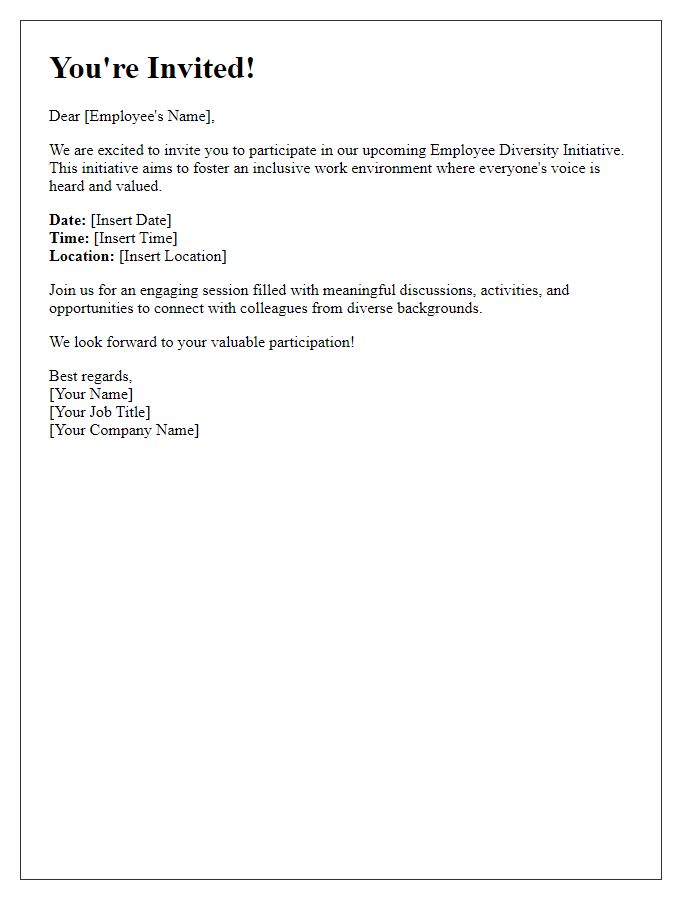In today's ever-evolving workplace, embracing diversity is not just a trend; it's a fundamental step towards creating a vibrant and inclusive environment for all employees. Our new diversity initiative aims to celebrate and harness the unique perspectives and talents that each individual brings to the team. By fostering a culture of understanding and respect, we can enhance collaboration and drive innovation across our organization. So, are you ready to join us on this exciting journey? Read on to discover how you can get involved!

Inclusive Language
Diversity initiatives focus on fostering an inclusive workplace culture, promoting respect for all employees regardless of their backgrounds. Using inclusive language--language that acknowledges and maintains the identity of all individuals--encourages open communication and collaboration. For instance, addressing colleagues by their preferred pronouns and using gender-neutral terms fosters a sense of belonging. Companies like Google and Microsoft actively incorporate inclusive language guidelines into their training materials, impacting workplace dynamics positively. Research shows that fostering diversity can lead to increased creativity and innovation, with diverse teams often outperforming homogenous ones by up to 35%. This commitment to inclusive language reflects the company's dedication to creating a welcoming environment for every employee.
Clear Objectives
A well-defined employee diversity initiative aims to foster an inclusive workplace environment where diverse backgrounds, perspectives, and experiences are valued and integrated into company culture. Clear objectives include improving recruitment processes to attract talent from underrepresented groups, establishing mentorship programs for minority employees to support career development, and implementing training sessions focused on unconscious bias and cultural competency, promoting understanding among colleagues. Regular assessments through employee surveys can measure the initiative's impact, identifying areas for improvement and celebrating successes. Engaging leadership showcases commitment, reinforcing the importance of diversity as a strategic priority for organizational growth and employee satisfaction.
Cultural Sensitivity
Cultural sensitivity is essential in promoting diversity within workplaces, shaping relationships in organizations such as Fortune 500 companies. This concept encompasses awareness and respect for diverse cultural backgrounds, including race, ethnicity, nationality, and religion. In a globalized environment, teams in cities like New York and London benefit from cultural sensitivity training, which enhances collaboration and innovation. Events like workshops or seminars can be organized, focusing on understanding cultural differences and reducing bias. This initiative fosters an inclusive workplace culture, increasing employee satisfaction and productivity while attracting diverse talent. Recognizing holidays, traditions, and customs from various cultures further enhances this initiative, showcasing a commitment to valuing every employee's unique contributions.
Actionable Steps
Implementing an employee diversity initiative involves several actionable steps to foster an inclusive workplace culture. First, conducting a comprehensive diversity audit can identify existing gaps in representation across various demographics, such as gender, ethnicity, and age. Establishing a diversity task force, comprising members from multiple levels within the organization, ensures diverse perspectives are included in the planning process. Providing diversity training sessions, focusing on unconscious bias and cultural competence, can enhance employees' awareness and understanding of inclusivity. Creating mentorship programs that connect underrepresented employees with leaders can promote career advancement opportunities. Additionally, setting measurable goals--such as increasing minority representation in leadership roles by 15% over the next three years--can hold the organization accountable. Regularly reviewing progress through surveys and feedback sessions allows for ongoing adjustments to the initiative, ensuring it remains effective and aligned with employee needs and company values.
Leadership Commitment
A leadership commitment to employee diversity initiatives is essential for fostering an inclusive workplace culture. Diversity encompasses various dimensions, including race, ethnicity, gender, sexual orientation, age, and disability status, contributing to a rich tapestry of perspectives. A commitment can manifest through measurable goals, such as increasing underrepresented groups' representation by 20% within three years, promoting equitable hiring practices, and ensuring comprehensive training for all employees on unconscious bias and cultural competency. Furthermore, support from leadership can ensure resources allocated for mentorship programs and community partnerships with organizations focused on diverse talent cultivation, thereby enhancing innovation and employee engagement. Effective communication of this commitment across platforms, like town hall meetings and internal newsletters, reinforces a culture of accountability and shared values among all team members.













Comments